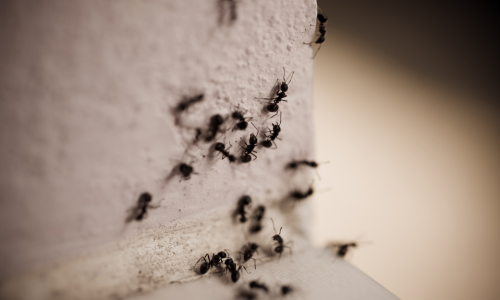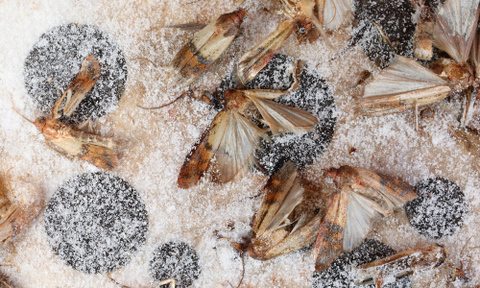We all stock up on items, whether it be because of a sale, the threat of severe weather, or the fear of a shortage. I can understand, as I don’t like to miss a day without sprinkling flaxseed, with its mild and nutty flavor and array of health benefits, over my hot cereal in the mornings. Nor can I imagine going a day without a steaming cup of biting hot, black coffee. But, having a pantry full of grains, cereals, nuts, and flours (and that’s just my top shelf) can be problematic. I have to ask myself what measures I should take to protect my foods from insects. I have had trespassers before. Will they trespass again?
>>> Get a FREE sample of our best-selling, non-toxic insect spray
What items do pests infest?
If you pantry is filled to the brim with baked beans, stacked cans of tuna, canned soup, and tomato paste, you’re in the clear. There’s not much that a pest can do with a can. (Without a can opener, there’s not much you or I could do with a can either.) But if you have boxes of macaroni and cheese, crunchy packets of your favorite cookies, granola bars, dried beans, tea, chocolate, spices, cured meats, or bags of basmati rice lining your pantry shelves, you’re very much not in the clear.
These items have an array of predators that are after its contents. Let’s name a few.
Ants

Ants love to eat and they’ll invite their extended family to the banquet. In order to properly treat an ant issue, it’s important to know what species of ant you’re dealing with. Sugar ants or pharaoh ants, for example, should’t be sprayed. (They’re the yellowish or brownish ant that can be identified by places and foods they infest: in your suburban kitchen, eating your tasty sweets.) If they are disturbed, they’ll disburse and bud into multiple colonies. For these ants, use Dr. Killigan’s Insect Buster® to disperse Dust to Dust Non-Toxic Insect Power. For all other ant types, our kill-on-contact non-toxic insect spray Six Feet Under® will do the trick, ending your bug battle.
Roaches
These greasy-looking insects will eat anything: starch, sugar, grease, meat, and cheese, as well as rotting fruits and vegetables. As if it couldn’t get any worse, they also love cardboard, especially if it’s wet. They’ll use it for shelter and food, eating the fibers and glue of the organic material.
Cockroaches prefer to shelter in narrow cracks and crevices and come out when your children are tucked tight in bed, your spouse is snoring (a little too loudly), and all is still and dark. Check areas that are especially dark, like behind your refrigerator or under your stove, or where crumbs might be found, for these nighttime foragers. They may be lurking close by.
These are miscreants that you want to immediately rid your home of. Look no further than Dr. Killigan’s Insect Buster. (I’ll share the necessarily rid-your-home-of-roaches details in just a bit.)
Moths

These winged invaders are your pantry’s worst enemy. They’ll find the perfect nesting ground and then lay their eggs on or near your bag of nearly-full flour, organic brown rice, pasta that you were going to make for dinner, or cereal that your children are eager to have a bowl of. (They nest where there’s dry food for their larvae)..This also includes pet food and bird seed.
Once the eggs hatch, the larvae will feast on any of these dry goods, gnawing their way through boxes and chewing through plastic. Your food is now contaminated. Your food items, now opened, are susceptible to other pests.
We have your back (and your pantry) covered. After ridding your cupboards (and your home) of the infested items, Dr. Killigan's Premium Pantry Moth Traps® are a sure way to reduce the flatter of these winged invaders. The potent pheromone in these traps attracts the males, thus ridding the female’s ability to reproduce.
Weevils
These long-snouted strange looking insects feed on grains and are often found in boxes or bags of stored whole-grain cereals and grains. Their favorite delights are raw seed grains; they tend to stay away from high processed grain products. The most susceptible foods are raw wheat, oats, barley, rye, rice, and corn.
Dust to Dust Non-Toxic Insect Powder exterminates weevils by piercing and drying out their exoskeletons. Use Dr. Killigan’s Insect Buster to disperse this powder.
Does your home have signs of bugs at play?
Let’s look for clues of a bug issue or a possible infestation. Many times, seeing one offender, or signs of one offender, means that there’s a party somewhere in your home that you clearly weren’t invited to. Ask yourself: Have you seen any of these creepy crawlies? If not, it’s still important to play detective and ask yourself if you’ve found any of their clues.
Ants
Ants aren’t sneaky fellows. You’ll see them and their friends. Ants leave behind a chemical trail that returning ants can follow later. If it’s carpenter ants you have, you’ll see small piles of sawdust.
Roaches
Roaches are filthy, leaving a trail of tiny dark brown dots (their feces) or smear marks (roach stains or liquified roach poop) for us to follow. You may also see their egg capsules, which can hold up to 30 nymphs and are shaped like a pill. They also leave a chemical trail to aid other roaches in returning to the newfound food source.
Moths

Pantry moths fly in zigzag lines and have wings that are pale gray. Their eggs are tiny and nearly invisible to the naked eye. Their larvae, gray-ish white, look like minute wiggling worms. The larvae will surely be seen, as these moth babies emerge in the hundreds.
Pantry moths infest and lay their eggs in grain-based products like flour, cereal, pasta, and baking mixes, though it doesn’t stop there. You can also find their larvae tucked into the edges of cans or spice jars, snuggled tight in the corners of your food storage area, packed tight like sardines in the crevices of your cupboard, or near a bag’s seal. Pantry moths will be nestled anywhere that’s near accessible food. It’s important to note that their larvae will easily chew through cardboard, paper, and thin plastic to get to its meal.
Weevils
If you’re pouring whole-grain oats (or another cereal grain) into a pot of boiling water and out comes a splash of tiny brown bugs, it’s weevils. You caught them in the act (and before they reproduced). These are active adult weevils.
If you open a bag of short-grain brown rice and see a dry, dusty residue from the hulls of seeds, it’s evidence of a weevil’s home for their eggs, larvae, and pupae. Pour this grain into a pot of water and this dusty residue will often float on the surface. I wouldn’t recommend cooking this rice.
How do I rid my pantry of insects?
Use diatomaceous earth for ants, roaches, and weevils

To rid your home of these creepy crawlies: First, make sure that the areas you want to treat are dry and clean. Using Dr. Killigan’s Insect Buster®, spread a thin coat of Dust to Dust on surfaces and in crevices where you’ve seen insect activity. Focus on areas that are dark and where these pests can find crumbs, like the backsides of stoves, refrigerators, and other appliances. Hit their entry points, including cracks, gaps, and outlets around wiring. Treat any wall voids—cracks or holes leading in the walls. Repeat, relax, and throw a party.
Dust to Dust is a powder insecticide that is non-toxic and non-poisonous. It has proven kill times of up to 50% faster than diatomaceous earth. It is known to be safe for humans and pets, and is a safe alternative to traditional insecticides. Dr. Killigan’s Insect Buster bulb is sturdy, easy to aim, and easy to store with Dust to Dust powder inside of it. It is great to spray into cracks and crevices that sprays can't reach.
Use Dr. Killigan’s pantry moth traps for moths
Three of Dr. Killigan’s Premium Pantry Moth Traps are the ideal number to place around the infested area in a triangular or web-like formation. Our traps are designed to attract the adult male moths to completely stop the life cycle of the pantry moth. Once they are full and your problem is under control, toss them and then keep one trap out and change it every three months. This is a preventative measure to keep any new moths from gaining a foothold. (Note: Once opened, the traps are good for three months.)
These traps are toxic-free and the pheromone is mixed right into the glue. They are a simple trifold design and have a stylish, classy look.
Use Dr. Killigan’s Six Feet Under for ants, roaches, moths, weevils and more
If you’re on the hunt for a superb kill-on-contact solution, use Dr. Killigan's Six Feet Under®. It is a popular kill-on-contact toxin-free spray that will dispose of most insects. It does not contain pyrethrin or pyrethroids and is made with a mixture of clove and cottonseed oils that is 100% safe to use around pets, children, and food areas of your home.
How do I protect my pantry from bugs?
Regardless of whether or not you currently have pesky invaders in your pantry, it’s time to take action. Today is the day.
Throw away infested product

Investigate, toss, and investigate and toss again. Rid your home of all infested products and then inspect your cupboards, your pantry shelves, and all food items for these intruders and their larvae. Given the chance, many of these insects will snack on almost anything. Look for evidence in and on all food packaging. Grain-based products like flour, cereal, pasta, and baking mixes, along with nuts, seeds, sweets, and powdered milk, though all dry good packages should be inspected. If you have pets, be sure to check their food too.
Following a deep cleaning, I recommend spraying Dr. Killigan’s Six Feet Under on your pantry shelves and walls, followed by wiping down every shelf, the sides of every walls, and each container, can, and package. This will ensure that no eggs or larvae were missed.
Refrigerate or freeze stored foods
If a food item is open, you do not necessarily have to toss it. A quick inspection from the outside of the packaging should tell you whether or not an individual food item needs to be trashed. If there are no signs of insects or their feces, I would not throw it out. If you have any doubts, wrap the item in a sturdy plastic bag and place it in the freezer for 48-72 hours. In the event you were wrong, the cold will ensure that you have no survivors. You can save a lot of food and a lot of money by taking this step.
Place stored items in sealed containers
Purchasing plastic, glass, or stainless steel containers with airtight lids is worth the investment. Let’s ensure that your goods remain bug-free. These containers will keep insects out better than cardboard, paper, or foil wrapping.
Monitor your pantry for pest activity
Clean your pantry every three to six months. This will help keep you organized and will keep pests at bay.
The final word on pantry protection
Our team of professionals is dedicated to perfecting the art of Killing Them Softly®. We have designed 100% toxin-free pest control products that are not only safe but are also created with style, restoring peace of mind and returning “classy” to your home.
We are continually raising the bar in toxin-free pest control remedies. All our products come in a design that is pleasing to the eye and carry a 100% satisfaction guarantee. If you are not satisfied for any reason, please contact us. We will not hesitate to make things right.










